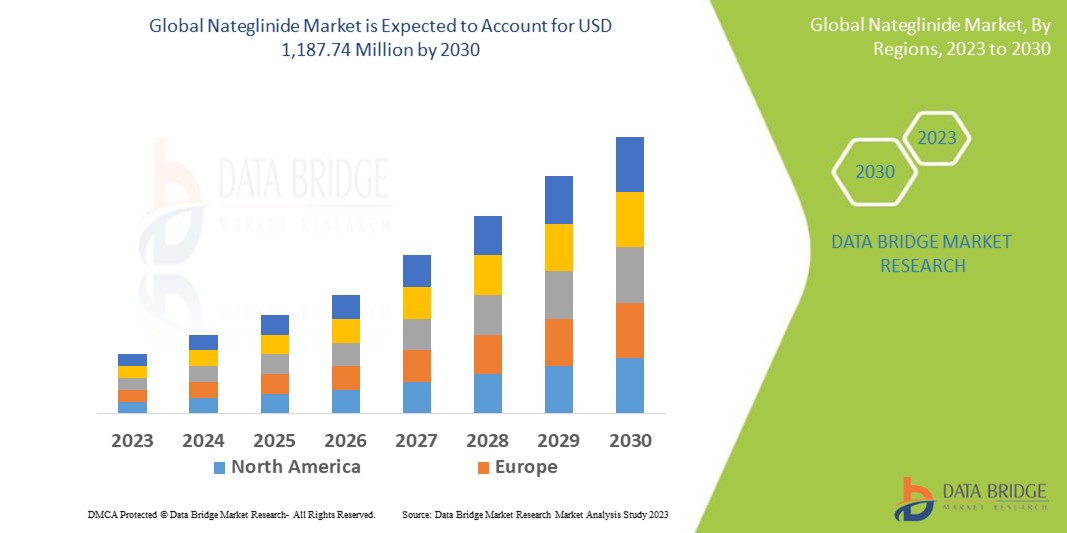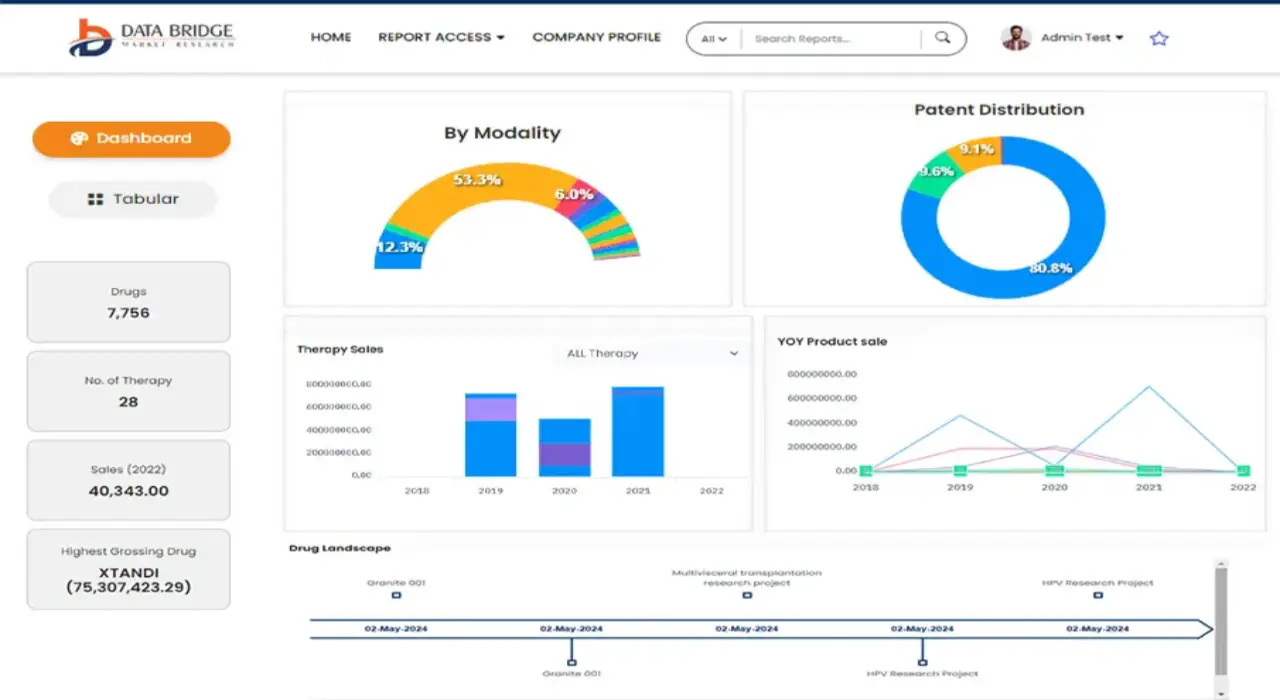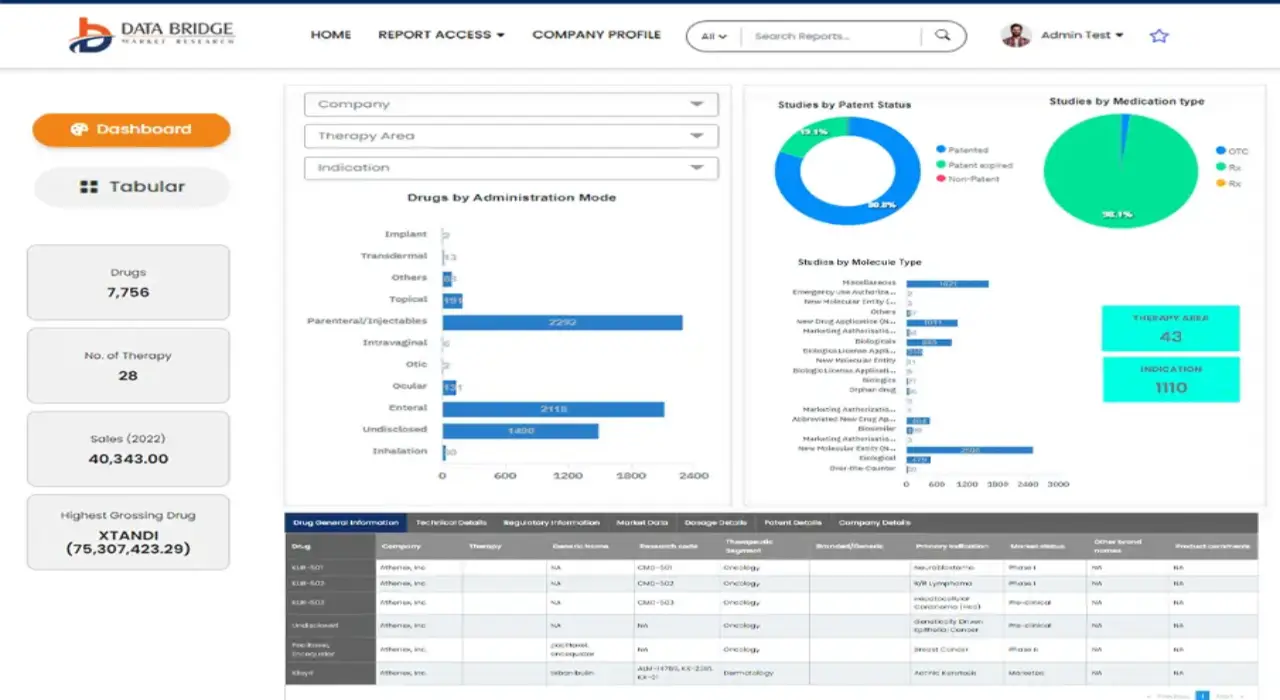Global Nateglinide Market
Market Size in USD Billion
CAGR :
% 
 USD
538.23 Billion
USD
1,187.74 Billion
2022
2030
USD
538.23 Billion
USD
1,187.74 Billion
2022
2030
| 2023 –2030 | |
| USD 538.23 Billion | |
| USD 1,187.74 Billion | |
|
|
|
|
Global Nateglinide Market, By Therapy Type (Monotherapy, Combinational Therapy), Indication (Diabetes, Obesity, Others), End-Users (Hospitals, Homecare, Specialty Clinics, Others), Distribution Channel (Hospital Pharmacy, Online Pharmacy, Retail Pharmacy) – Industry Trends and Forecast to 2030.
Nateglinide Market Analysis and Size
The rising global burden of diabetes, particularly type 2 diabetes, is a major driver for the nateglinide market. The growing diabetic population has increased the demand for effective oral antidiabetic drugs like nateglinide.
Data Bridge Market Research analyses that the global nateglinide market which was USD 538.23 Million in 2022, would rocket up to USD 1,187.74 Million by 2030, and is expected to undergo a CAGR of 10.4% during the forecast period. This indicates the market value. “Monotherapy” is expected to dominate the technique segment of the global nateglinide market owing to the increasing investment in healthcare. In addition to the insights on market scenarios such as market value, growth rate, segmentation, geographical coverage, and major players, the market reports curated by the Data Bridge Market Research also include depth expert analysis, patient epidemiology, pipeline analysis, pricing analysis, and regulatory framework.
Nateglinide Market Scope and Segmentation
|
Report Metric |
Details |
|
Forecast Period |
2023 to 2030 |
|
Base Year |
2022 |
|
Historic Years |
2021 (Customizable to 2015-2020) |
|
Quantitative Units |
Revenue in USD Million, Volumes in Units, Pricing in USD |
|
Segments Covered |
Therapy Type (Monotherapy, Combinational Therapy), Indication (Diabetes, Obesity, Others), End Users (Hospitals, Homecare, Specialty Clinics, Others), Distribution Channel (Hospital Pharmacy, Online Pharmacy, Retail Pharmacy) |
|
Countries Covered |
U.S., Canada and Mexico in North America, Germany, France, U.K., Netherlands, Switzerland, Belgium, Russia, Italy, Spain, Turkey, Rest of Europe in Europe, China, Japan, India, South Korea, Singapore, Malaysia, Australia, Thailand, Indonesia, Philippines, Rest of Asia-Pacific (APAC) in the Asia-Pacific (APAC), Saudi Arabia, U.A.E, South Africa, Egypt, Israel, Rest of Middle East and Africa (MEA) as a part of Middle East and Africa (MEA), Brazil, Argentina and Rest of South America as part of South America |
|
Market Players Covered |
Pfizer Inc (U.S.), AstraZeneca (U.K.), Bristol-Myers Squibb Company (U.S.), Dr. Reddy's Laboratories Ltd (India), Endo International plc (Ireland), Teva Pharmaceutical Industries Ltd (Israel), Sun Pharmaceutical Industries Ltd (India), Mylan N.V. (U.S.), Novartis AG (Switzerland), Lupin (India), Cipla Inc (India), Aurobindo Pharma (India), Dr. Reddy’s Laboratories Ltd (India), Zydus Group (India), Nivagen Pharmaceuticals. (U.S.) |
|
Market Opportunities |
|
Market Definition
The global nateglinide market is the market for the pharmaceutical product nateglinide. Nateglinide is an oral antidiabetic medication used for the management of type 2 diabetes mellitus. It belongs to the class of drugs known as meglitinides and works by stimulating the release of insulin from the beta cells of the pancreas, thereby helping to control blood sugar levels.
Global Nateglinide Market Dynamics
Drivers
Technological Advancements
Advances in pharmaceutical research and development have led to the introduction of more efficient and targeted antidiabetic medications. These advancements have positively impacted the Nateglinide market, as new formulations and drug delivery systems continue to emerge.
Increasing Diabetes Prevalence
The rising global burden of diabetes, particularly type 2 diabetes, is a major driver for the Nateglinide market. The growing diabetic population has increased the demand for effective oral antidiabetic drugs like nateglinide.
Opportunities
Increasing Diabetes Awareness
With a growing emphasis on preventive healthcare and increasing awareness about diabetes, there is an opportunity to educate people about the importance of early diagnosis and effective management. This can lead to an increased demand for antidiabetic medications like Nateglinide.
Furthermore, the rising collaboration, merger, and acquisition among the market players will extend profitable opportunities for the market players in the forecast period of 2023 to 2030. Additionally, the rising number of market players will further expand the market's growth rate in the future.
Restraints/Challenges
Patent Expiry and Generic Competition
The patent protection for Nateglinide may expire, allowing generic manufacturers to enter the market and offer lower-priced alternatives. This can lead to increased competition, price erosion, and reduced market share for branded Nateglinide products.
On the other hand, the high cost associated with product manufacturing is expected to obstruct market growth. Also, the disruption in the supply chain industry has the potential to challenge the market’s growth. Also, the lack of favorable reimbursement scenarios and technology penetration in the developing economies, and lack of suitable infrastructure are projected to challenge the market in the forecast period of 2023-2030.
This global nateglinide market report provides details of new recent developments, trade regulations, import-export analysis, production analysis, value chain optimization, market share, impact of domestic and localized market players, analyses opportunities in terms of emerging revenue pockets, changes in market regulations, strategic market growth analysis, market size, category market growths, application niches and dominance, product approvals, product launches, geographic expansions, technological innovations in the market. To gain more info on the global nateglinide market contact Data Bridge Market Research for an Analyst Brief, our team will help you take an informed market decision to achieve market growth.
Recent Development
- As per the records of the WHO, global occurrence of obesity has nearly tripled since 1975. In 2016, over 1.9 billion adults, 18 years and older, were overweight. Of these, over 650 million were obese. 39% of adults aged 18 years and over were overweight in 2016, and 13% were obese. Obesity can lead to many CVDs and other diseases and in return increases the use of these agents.This boosts the market growth
Global Nateglinide Market Scope
The global nateglinide market is segmented on the basis of therapy type, indication, end-user, and distribution channel. The growth amongst these segments will help you analyse meager growth segments in the industries and provide the users with a valuable market overview and market insights to help them make strategic decisions for identifying core market applications.
Therapy Type
- Monotherapy
- Combination Therapy
Indication
- Diabetes
- Obesity
- Others
End-User
- Hospitals
- Homecare
- Specialty Clinics
- Others
Distribution Channel
- Hospital Pharmacy
- Online Pharmacy
- Retail Pharmacy
Global Nateglinide Market Regional Analysis/Insights
The global nateglinide market is analyzed, and market size insights and trends are provided by therapy type, indication, end-user, and distribution channel as referenced above.
The countries covered in the global nateglinide market report are U.S., Canada and Mexico in North America, Germany, France, U.K., Netherlands, Switzerland, Belgium, Russia, Italy, Spain, Turkey, Rest of Europe in Europe, China, Japan, India, South Korea, Singapore, Malaysia, Australia, Thailand, Indonesia, Philippines, Rest of Asia-Pacific (APAC) in the Asia-Pacific (APAC), Saudi Arabia, U.A.E, South Africa, Egypt, Israel, Rest of Middle East and Africa (MEA) as a part of Middle East and Africa (MEA), Brazil, Argentina and Rest of South America as part of South America
North America is expected to dominate the market due to factors including rising healthcare costs, increased R & D, and trending technological advancements.
Asia-Pacific is expected to witness the fastest growth during the forecast period of 2023 to 2030 because of the rising strategic initiatives by the key market players and favourable government initiatives in the region.
The country section of the report also provides individual market impacting factors and changes in market regulation that impact the current and future trends of the market. Data points like down-stream and upstream value chain analysis, technical trends, and porter's five forces analysis, and case studies are some of the pointers used to forecast the market scenario for individual countries. Also, the presence and availability of global brands and their challenges faced due to large or scarce competition from local and domestic brands, the impact of domestic tariffs, and trade routes are considered while providing forecast analysis of the country data.
Healthcare Infrastructure Growth Installed Base and New Technology Penetration
The nateglinide market also provides you with detailed market analysis for every country's growth in healthcare expenditure for capital equipment, installed base of different kind of products for the nateglinide market, impact of technology using lifeline curves and changes in healthcare regulatory scenarios and their impact on the nateglinide market. The data is available for the historic period 2015-2020.
Competitive Landscape and Global Nateglinide Market Share Analysis
The nateglinide market competitive landscape provides details by competitor. Details included are company overview, company financials, revenue generated, market potential, investment in research and development, new market initiatives, global presence, production sites and facilities, production capacities, company strengths and weaknesses, product launch, product width and breadth, application dominance. The above data points provided are only related to the companies' focus related to Nateglinide market.
Some of the major players operating in the nateglinide market are:
- Pfizer Inc (U.S.)
- AstraZeneca (U.K.)
- Bristol-Myers Squibb Company (U.S.)
- Dr. Reddy's Laboratories Ltd (India)
- Endo International plc (Ireland)
- Teva Pharmaceutical Industries Ltd (Israel)
- Sun Pharmaceutical Industries Ltd (India)
- Mylan N.V. (U.S.)
- Novartis AG (Switzerland)
- Lupin (India)
- Cipla Inc (India)
- Aurobindo Pharma (India)
- Dr. Reddy’s Laboratories Ltd (India)
- Zydus Group (India)
- Nivagen Pharmaceuticals. (U.S.)
SKU-
Get online access to the report on the World's First Market Intelligence Cloud
- Interactive Data Analysis Dashboard
- Company Analysis Dashboard for high growth potential opportunities
- Research Analyst Access for customization & queries
- Competitor Analysis with Interactive dashboard
- Latest News, Updates & Trend analysis
- Harness the Power of Benchmark Analysis for Comprehensive Competitor Tracking
Research Methodology
Data collection and base year analysis are done using data collection modules with large sample sizes. The stage includes obtaining market information or related data through various sources and strategies. It includes examining and planning all the data acquired from the past in advance. It likewise envelops the examination of information inconsistencies seen across different information sources. The market data is analysed and estimated using market statistical and coherent models. Also, market share analysis and key trend analysis are the major success factors in the market report. To know more, please request an analyst call or drop down your inquiry.
The key research methodology used by DBMR research team is data triangulation which involves data mining, analysis of the impact of data variables on the market and primary (industry expert) validation. Data models include Vendor Positioning Grid, Market Time Line Analysis, Market Overview and Guide, Company Positioning Grid, Patent Analysis, Pricing Analysis, Company Market Share Analysis, Standards of Measurement, Global versus Regional and Vendor Share Analysis. To know more about the research methodology, drop in an inquiry to speak to our industry experts.
Customization Available
Data Bridge Market Research is a leader in advanced formative research. We take pride in servicing our existing and new customers with data and analysis that match and suits their goal. The report can be customized to include price trend analysis of target brands understanding the market for additional countries (ask for the list of countries), clinical trial results data, literature review, refurbished market and product base analysis. Market analysis of target competitors can be analyzed from technology-based analysis to market portfolio strategies. We can add as many competitors that you require data about in the format and data style you are looking for. Our team of analysts can also provide you data in crude raw excel files pivot tables (Fact book) or can assist you in creating presentations from the data sets available in the report.













